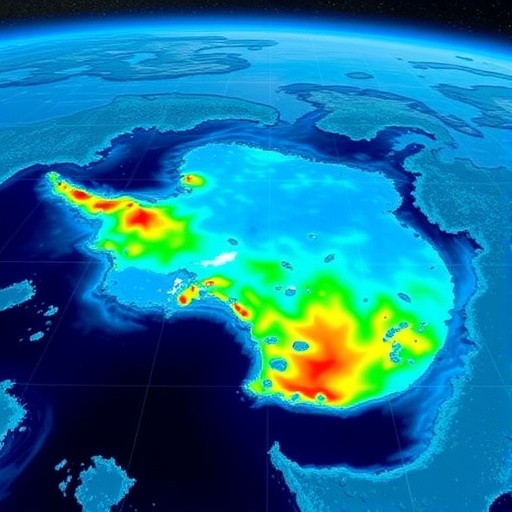Recent research has unveiled a significant interplay between turbulent vertical heat flux and oceanic currents beneath the sea ice of Antarctica, particularly emphasizing the role of the Amundsen Sea Undercurrent. The study, spearheaded by Wang and colleagues, explores how these dynamic oceanic processes contribute to the unique thermal environment present in these remote regions. As climate change continues to exert its influence on global weather patterns and oceanic behavior, understanding these interactions becomes ever more crucial.
The Amundsen Sea Undercurrent, a crucial feature of the Antarctic circumpolar current system, plays a pivotal role in transporting warmer water towards the ice shelves. This process not only influences the melting rates of the ice but also affects marine ecosystems reliant on stable temperature conditions. In their study, the authors utilized sophisticated modeling techniques and in-situ observations to delineate how heat is transferred vertically through turbulent processes beneath the ice.
At first glance, the term “turbulent vertical heat flux” may seem esoteric, yet it encapsulates essential mechanisms at work beneath the surface of the Antarctic ice. When ocean water rises to the interface between the sea and the ice, it carries thermal energy with it. Understanding the intensity and mechanism of these upward heat flows is vital for predicting the future of Antarctica’s ice cover amid changing climatic conditions. The current research reveals that the Amundsen Sea Undercurrent enhances this phenomenon significantly, effectively intensifying the turbulent heat exchange.
Crucially, the study highlights not only the role of the Amundsen Sea Undercurrent itself but also the broader implications for Antarctic ice shelf stability. As ice shelves retreat and diminish due to warming waters, the inextricable link between oceanic currents and ice dynamics emerges as a significant area of focus. Enhanced turbulent heat fluxes could lead to increased melting rates, thereby contributing to rising sea levels and global climate shifts that resonate far beyond the Antarctic region.
The researchers employed advanced technologies, including autonomous underwater vehicles and moored instruments, to capture fine-scale measurements of temperature and velocity in turbulent water. Such methodologies allowed for the resolution of complex physical processes that govern heat exchange beneath the ice. These technological advancements have opened new avenues for in-depth oceanographic studies, offering insights that were previously unattainable.
As the study progressed, the findings pointed toward a concerning trend: the current dynamics contribute to accelerated melting of the ice shelves. The coupling of ocean dynamics and ice behavior presents a dual challenge for climate scientists and policymakers aiming to mitigate the impacts of global warming. As the findings elucidate, heat transported by the undercurrent fosters not just localized melting but poses a broader threat when considering the cumulative effects on the West Antarctic Ice Sheet.
Moreover, the implications of this research extend beyond mere observations of melting ice. The interplay of turbulent heat flux and ocean currents also has repercussions for the diverse marine life depending on the fractal patterns of ice cover. Different species rely on specific thermal niches that could be disrupted due to accelerated melting. This ripple effect throughout the food web begs a critical examination of how even small changes in one area can lead to significant ecological consequences.
Additionally, the research team brought to light the complex feedback loops linking atmospheric temperatures, ocean properties, and ice dynamics. Increased atmospheric warmth leads to greater ice melt, which in turn influences ocean salinity and temperature—factors that could amplify the strength or behavior of the Amundsen Sea Undercurrent. Such a cascading effect highlights the intricate web of interactions within the polar region, urging an interdisciplinary approach to understand these phenomena comprehensively.
As we pivot towards a more comprehensive discussion regarding policy and mitigation strategies, the findings from Wang et al. underscore the urgency of international collaboration in climate science. Countries that share interest in Antarctic research must pool their resources and expertise to better forecast potential outcomes. This research not only provides data but also a clarion call for proactive measures to address the pressing issues surrounding climate change and its broad-reaching implications.
In conclusion, this innovative study on turbulent vertical heat flux under Antarctic sea ice situates itself at the crossroads of marine science, climate dynamics, and ecological theory. The role of the Amundsen Sea Undercurrent is paramount, aiding our understanding of how oceanic processes fuel changes in ice dynamics. With the atmospheric conditions continuing to evolve, researchers underscore the research as foundational, guiding future studies aimed at unraveling the complexities of climate interactions and their consequent effect on both environmental and human systems.
It is evident that ongoing and future research must embrace a holistic view. As the growing body of literature highlights the urgency faced by polar regions, there is a profound need for sustained observation and modeling of these systems—each finding leads us a step closer to unraveling the intricate tapestry of climate dynamics that governs our planet.
By integrating these approaches, researchers, policymakers, and the public can foster a greater understanding of the oceans and their interaction with climate. Ultimately, the study serves as a reminder of the unexpected and intricate ties that bind our planet’s systems, illustrating the urgency with which we must navigate the challenges posed by climate changes.
Subject of Research: Turbulent vertical heat flux under Antarctic on-shelf sea ice
Article Title: Turbulent vertical heat flux under Antarctic on-shelf sea ice intensified by the Amundsen Sea Undercurrent
Article References:
Wang, X., Silvano, A., Firing, Y. et al. Turbulent vertical heat flux under Antarctic on-shelf sea ice intensified by the Amundsen Sea Undercurrent.
Commun Earth Environ 6, 613 (2025). https://doi.org/10.1038/s43247-025-02598-2
Image Credits: AI Generated
DOI:
Keywords: Turbulent vertical heat flux, Antarctic sea ice, Amundsen Sea Undercurrent, climate change, ice shelf dynamics, ocean dynamics, marine ecosystems, heat exchange.




